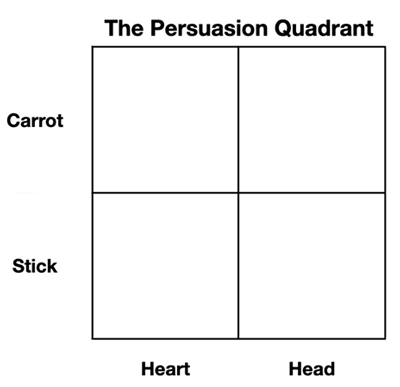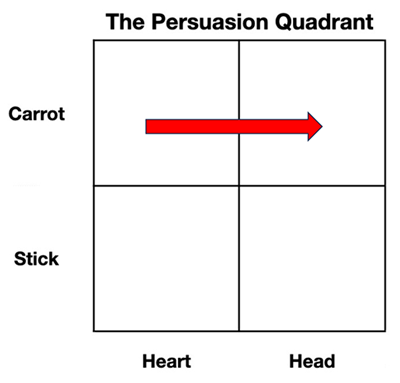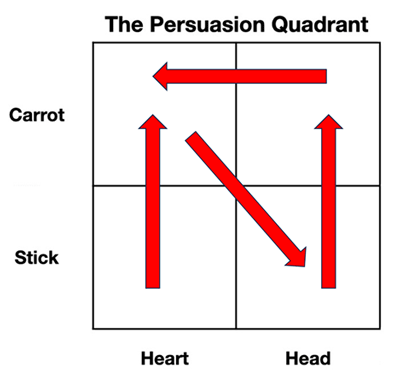Keyword: Persuasion
People decide with their hearts and justify with their heads. Knowing that, and knowing what to do with it, will make you a more effective communicator. Also, a lesson that my old boss, Rick Parkhill, taught me about persuasion.
By Brad Berens
The word “persuasion” gets a bad rap because it sounds like a con job where the persuader pulls one over on an unsuspecting mark. P.T. Barnum famously had a sign that read “This Way to the Great Egress!” that fooled circus goers into going through a door to see another carnival exhibit, “the egress,” only to find themselves having exited the carnival. They had to pay again to get back in.
That’s not persuasion. That’s just lying.
The most important aspect of persuasion is empathy. You have to know about the other person’s life, job, likes, dislikes. The more you know, the easier it is to co-create a reality that includes things that you both want.
Usually, businesspeople talk about friction as a bad thing, but with persuasion friction is your friend. The more embodied and immersive a conversation you have when you’re trying to convince somebody to do something, the more likely you are to get their attention, and attention is the first step towards persuasion.
It sounds like I’m only talking about one-to-one persuasion, but I’m not. Advertising works by taking categories of things that lots of people want and then constructing narratives around how their products might fit into those desires. The more friction in the environment where somebody experiences a narrative, the more likely they are to engage.
You are, for example, more likely to buy a souvenir t-shirt at a concert than to order one online later because you want to remember the concert and be able to show off that you were there when you wear the t-shirt. Disneyland is a massive exercise in immersive persuasion that people pay big bucks to visit. It’s not one-to-one.
The disembodied frictionlessness of digital media means that it’s harder to persuade somebody online than in person. When you get hundreds of emails each day, the horde drowns out individual voices yielding little attention.
Know the stakes
In addition to empathy and attention, it’s also important to know the stakes of the other person’s decision because the higher the stakes, the greater the effort you need to make. Your stakes as a reader of this column are low. All of the columns on the Center’s website are free, so there are no economic stakes. If you’ve read other pieces that I’ve written here, then (I pray) you’re moderately confident that you’ll smile at least once and go, “huh… interesting” at least once. Likewise, if I’m going to be in your town and suggest we grab a cup of coffee, those too are low stakes.
However, if I’m asking you to fly from San Francisco to New Delhi in order to give a talk at a conference I’m producing, and if I’m not offering you a speaker fee, then I’d better have a highly customized, thoughtful, and compelling reality I want you to co-create with me.
Some years ago, I did just that with my friend S, a senior marketer who was born in New Delhi. I knew that if I just asked him to speak, then his primary consideration would be his schedule. Instead, I said, “your mom doesn’t understand what you do for a living, and she still lives in New Delhi, right?” He said yes. I then pitched him on a keynote to which we’d invite his family to be in the audience, where they could both get a sense of what he does and see the esteem his industry has for him.
S couldn’t say no to that.
By the way, persuading somebody to do something isn’t the end of your job as a persuader: it’s the start. I was the MC for that show in India, and before I welcomed S to the stage I pointed to his mom in the audience. She stood up with an expression of fierce pride that still makes me tear up when I think about it.
The Persuasion Quadrant
In addition to empathy and attention, persuasion also requires understanding what kind of response you’re trying to elicit. Despite what classical Economics tell us, people generally aren’t rational actors. That doesn’t mean that they’re irrational actors. It just means that people tend to decide with their hearts and then justify those decisions with their heads later.
If you follow that cadence and lead with a heart reason followed by a head reason, then you’re more likely to persuade the person than with the reverse sequence.
That’s what happened with my friend S. I led with an appeal to his heart, but I backed it up with an additional appeal to his head since this was a major conference with lots of colleagues and press and other things speakers like. (Elsewhere, I’ve talked about this sort of thing as “the two-strategy strategy,” which will probably become another Keyword entry at some point.)
People also respond more quickly to loss than to gain. Fear is more powerful than greed.
A while back, I developed the Persuasion Quadrant to help people focus their messages:

At the time I first wrote about this, I was concerned with localizing an overall message on the chart. These days, though, I’m thinking about movement across the chart. Persuasive exercises exist in time, and you can think about each exercise as a journey from one quadrant to another.
With my friend S, the journey was this:

But I can imagine other journeys from the simple to the complex like this:

The point is that every persuasive exercise—even something as simple as an email subject line—has a beginning, middle, and end, so thinking about the other person’s journey will make you more effective.
What’s in it for all parties?
One of the best lessons in persuasion I ever got came from Rick Parkhill, who was my CEO at iMedia Communications. That’s where I had my first Editor in Chief stint running content for the sadly-now-defunct daily media property, iMedia Connection.
Confession: I’m an advertising heretic. Even though I’ve worked in ad tech for years, I’m not-so-secretly invested in the value of personal privacy. I’ve donated to the Electronic Frontier Foundation, think that the legislative initiatives popping up all over the world to prevent big tech from tracking our every click are great ideas, and want Congress to remove the Section 230 protections that give online companies immunity from all the hateful, harmful, cyberbullying and misinformation that happens on their platforms.
Back in my iMedia days, I wanted to organize a panel at the 2005 Computers, Freedom, and Privacy Conference where two companies selling behavioral targeting for advertising and two privacy advocates would debate.
I pitched Rick the idea, whereupon he raised his eyebrows and asked, “What’s in it for iMedia?” It was a great question. The ad tracking companies and privacy advocates would all benefit from learning more about each other, and the audience would benefit from learning about the complexities of the issue, but how would iMedia benefit?
My answer, after I thought about it for a moment, was three-fold. First, it would bond us more closely to the two behavioral targeting companies that were frequent contributors and sponsors. Second, it would present iMedia as a platform for thought leadership around these issues to a broader audience that wasn’t familiar with our work. Third, I’d get exposed to a wider conversation around these and other issues, which would make me more effective in my job.
Rick listened, shrugged, and said, “OK.” I started making plans for the conference.
His question has stuck with me ever since, and I’ve asked it of others many, many times. “What’s in this for you?” doesn’t mean that you have to approach things transactionally. Instead, it means that you need to be clear-sighted about why you’re doing something. Those reasons can be self-interested, altruistic, or both, but if you don’t know why you’re doing it, then why bother?
Sometimes, the first person you need to persuade is yourself.
__________

Brad Berens is the Center’s strategic advisor and a senior research fellow. He is principal at Big Digital Idea Consulting. You can learn more about Brad at www.bradberens.com, follow him on Post and/or LinkedIn, and subscribe to his weekly newsletter (only some of his columns are syndicated here).
See all columns from the Center.
May 24, 2023

